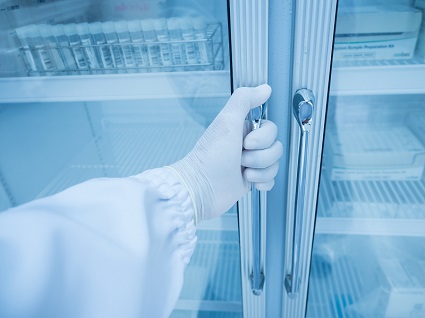Cancer identification research
Overview
Oncology research is pushing the bounds of cancer identification. Cells shed degraded DNA into the bloodstream due to normal processes. Cell free or circulating DNA (cfDNA) can be isolated from plasma to assay for circulating tumor DNA released from tumors. Researchers are developing tools to track cfDNA to improve cancer identification.
How does cancer identification work?
Two common methods used in the research field to identify cancer include the standard tissue biopsy as well as blood testing known as liquid biopsy. Liquid biopsy is a testing method that looks for cell-free DNA (cfDNA), cell-free RNA (cfRNA) or other tumor-derived markers in biofluid samples (e.g., blood, saliva). Small tumors shed nucleic acids, also called cell-free DNA (cfDNA), into the bloodstream, and genetic signatures from the tumor can be identified through next generation sequencing (NGS) of the DNA extracted from blood. Research focuses on liquid biopsy sampling methods because it provides a non-invasive approach for tumor profiling, measuring minimal residual disease, and the discovery of cancer biomarkers.
Challenges of circulating tumor DNA (ctDNA)
The amount of cfDNA in blood is very small, so sequencing technologies must be extremely efficient. Next generation sequencing has 3 main steps: library prep, sequencing, and analysis. During the library preparation step, DNA is converted into libraries, which allow the sample to be sequenced. A high conversion rate of DNA to library during the library preparation step will increase the identification of low frequency variants.
Error correction and accuracy can be further enhanced through the use of unique molecular identifiers (UMls). UMls are short sequences, often with degenerate bases, that incorporate a unique barcode onto each molecule within a given sample library. UMls have been shown to reduce the rate of false-positives and improve variant identification. By incorporating individual barcodes on each original DNA fragment, variant alleles present in the original sample (true variants) can be distinguished from errors introduced during library preparation, target enrichment, or sequencing. Any identified errors can be removed by bioinformatics methods before final data analysis.
Cancer research and the benefits of using liquid biopsy
Liquid biopsies offer several benefits over traditional tissue biopsy for studying cancer. Tissue biopsy relies on localized sampling of cancerous tissue to study the disease, usually through a time consuming, invasive, and technically difficult sampling process. Since liquid biopsy uses bodily fluids like blood or salvia, samples can be collected in a technically low-risk, non-invasive, and affordable manner.
Further, because liquid biopsy allows researchers to monitor and track cfDNA that has been released by tumor cells (ctDNA) [2], they can gain a more comprehensive understanding of the genetic makeup of a tumor. This is beneficial because the high level of heterogeneity of tumors makes it challenging for researchers to thoroughly identify cancer-related mutations from localized tissue biopsy samples alone. The genetic picture provided by liquid biopsy samples can allow researchers to take a broader approach towards cancer-related biomarkers, not just those obtained from a single sampled area.
While liquid biopsy has a number of important benefits over tissue biopsy, researchers use these two approaches in tandem to better assess the evolution of cancer overtime, monitor MRD, and quantify mutational loads.
The future of personalized genomics
Munich Leukemia Laboratory (MLL) is a leading institution for leukemia research. Watch this webinar to learn how MLL is aiming to advance hematology research with NGS, the pivotal role NGS plays in genetic profiling and personalized medicine, and how targeted panel sequencing allows for deeper investigation into genetic research questions.
Applicable research technologies
Targeted next generation sequencing
Targeted next generation sequencing (NGS) focuses on specific regions of interest in the genome. With targeted NGS, researchers can target specific genes, coding regions, or even chromosomal segments at deeper coverage than alternative sequencing methods, obtaining fast, accurate, and precise genomic insights.
Hybridization capture
Hybridization capture is a targeted next generation sequencing method that uses long, biotinylated oligonucleotide baits (probes) to hybridize to the regions of interest. It is particularly helpful when genotyping, rare variants, and exome sequencing.
Cancer exome sequencing
Genetic mutations are more likely to impact health outcomes when they occur in protein-coding genes. Exons that make up the protein-coding genes comprise 1% of the human genome, so focusing sequencing on this portion of the genome is more cost-effective than whole genome sequencing and will provide more comprehensive data than other sequencing methods. This approach can fast-track research in areas such as cancer genomics, which will benefit from the identification of novel biomarkers.
Minimal residual disease (MRD) research
Tomorrow’s cancer research breakthroughs are on the horizon. The xGen MRD solution offers a complete sample preparation workflow including custom MRD hybridization capture panels delivered quickly and affordably.
Products for cancer research
Let's connect
Uncover biomarkers with confidence.
Our NGS team is ready to answer questions to help you reach your biomarker discovery research goals. Fill out this form and one of our team members will contact you directly.
xGen NGS—made for cancer research.
References
- Lone SN, Nisar S, Masoodi T, et al. Liquid biopsy: a step closer to transform diagnosis, prognosis and future of cancer treatments. Mol Cancer. 2022;21(1):79.
- Neumann MHD, Bender S, Krahn T, et al. ctDNA and CTCs in Liquid Biopsy - Current Status and Where We Need to Progress. Comput Struct Biotechnol J. 2018;16:190-195.
*RUO—For research use only. Not for use in diagnostic procedures. Unless otherwise agreed to in writing, IDT does not intend for these products to be used in clinical applications and does not warrant their fitness or suitability for any clinical diagnostic use. Purchaser is solely responsible for all decisions regarding the use of these products and any associated regulatory or legal obligations.
RUO22-1331_001
